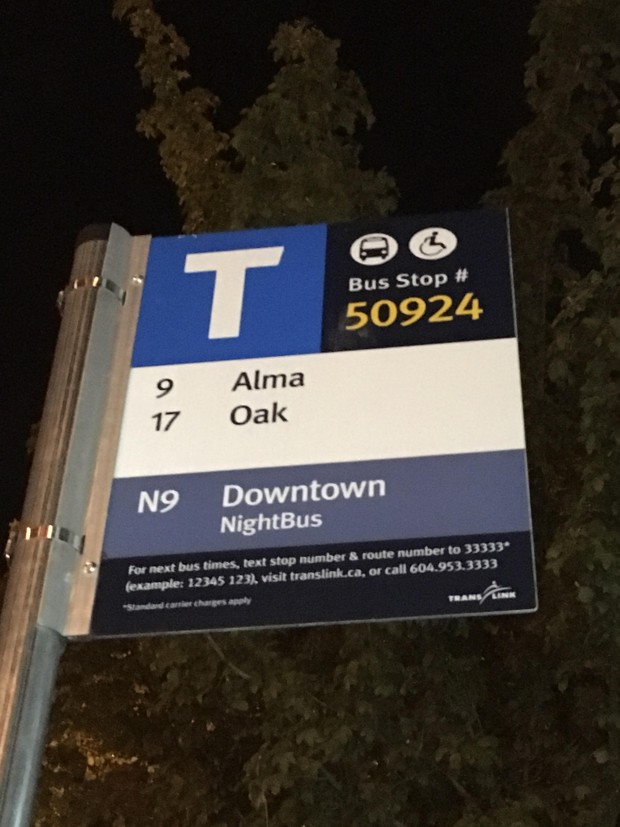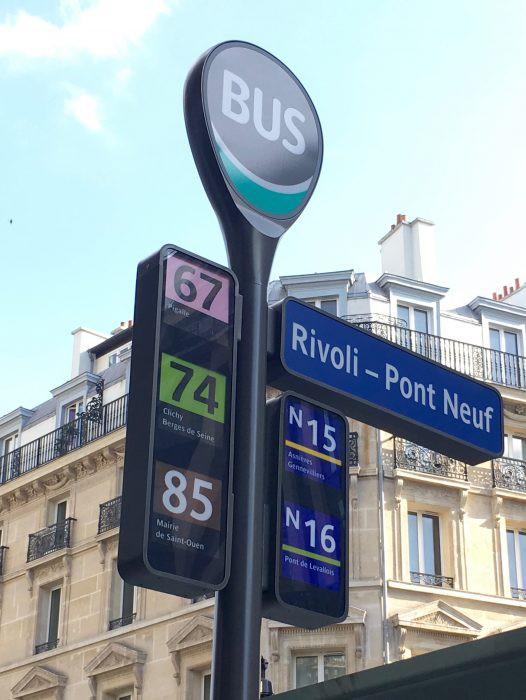Connecting state and local government leaders
Clear wayfinding displays can help bus riders feel more confident, and give a whole city’s public transportation system an air of greater authority.
Of all the challenges that riding the bus can present to riders, few seem as easy to correct as abysmal signage. From simple omissions of useful facts, to total illegibility, to plain nonexistence, bad signs are pervasive in public transit. Rail systems are no stranger to this—looking at you, Penn Station—but the problem is especially rampant in city bus systems, which often get the least amount of aesthetic and infrastructural attention from their municipal overseers.
When I put out a call on Twitter for examples of transit signage fails, I received a host of offenders from coast to coast. In San Francisco—a “transit first” city—bus route numbers are spray-painted in tiny font onto adjacent, often weathered telephone poles. In Tampa, some bus stop signs consist of stumpy metal flags planted in tire-shaped weights. Wichita, Texas, has signs that are simply repurposed street parking placards; in Nashville, bus signs don’t even mention which routes appear there. Pittsburgh has bus signs that don’t mention the name of the transit agency. And the lack of wayfinding infrastructure at transit stations in Denver leaves riders wandering vast plains of asphalt.
My local stop in Potrero :( pic.twitter.com/QdM7JjMZ9u
— Marcel Moran (@marcelemoran) September 6, 2019
What makes a good bus stop sign so hard to find? Part of the answer is the amount of professional expertise it takes to develop clear and useful information displays. Many agencies lack specialized staff or resources; responsibility for sign projects is often left to managers who are really in charge of other projects. “Often, competing priorities result in minimal attention being given to these activities,” wrote John Dobies, a Kansas City transit planner, in a 1996 white paper on the subject published by the Transportation Research Board.
Oh wow, where to start (sadly). Wichita, KS where bus stop signs are just repurposed no parking signs. pic.twitter.com/NUGPaB26BU
— Paul Supawanich (@tweetsupa) September 6, 2019
Another part of the answer relates to many other problems that plague transit agencies, which is the low status that most cities grant bus riders, and the scant funding that local and state governments provide to bus service overall. Buses are widely presumed to be, and treated as, the mode of non-choice for the poorest urban denizens.
This is great news. Thank you, Councilmember. Can you also get the bus stop situation there sorted out? The bus shelter is more than 100 feet from the bus stop, and if you are in the shelter, the drivers don't see you & skip the stop. pic.twitter.com/ggrLt9K9kg
— Marc (@mcas_LA) September 5, 2019
That is why bus routes often fall to the chopping block in times of economic pain, why dedicated bus lanes that dramatically speed travel times are incredibly rare, and why—in addition to illegible signage—bus stops themselves are often unpleasant, unsafe, and/or inaccessible. (See: Streetsblog’s annual bracket contest to find North America’s sorriest bus stop. Recent winners include a metal sign on a highway in British Columbia, a patch of grass next to an active freight rail track in Seattle, and a glorified roadside drainage ditch in Silver Spring, Maryland.)
Sadly, the lack of investment in bus service is one of many reasons that bus ridership is steadily declining around the U.S. In 2018, public transit ridership fell to its lowest point since 2006, according to data from the American Public Transportation Association. Buses—the backbone of mass transit systems in most cities—have experienced the most dramatic drops, with ridership falling more than 14 percent nationwide since 2013. Cheap gas and easy credit for car loans are pulling riders towards private cars, as are ride-hailing services like Uber and Lyft in major cities. But research also shows that the bus passenger experience—measured by factors like where the network goes, the frequency and timeliness of bus arrivals, and overall navigability of the system—can push people away if it’s not on-par.
The good news is that better signage is low-hanging fruit for agencies that want to step up their service. Digital display-makers such as TransitScreen and apps like Moovel and Transit are working on private-sector solutions to the signage problem and in some cases, are working with transit agencies to help. But officials shouldn’t assume that all riders are navigating with a smartphone, said Mary Buchanan, a research associate at the public transportation think tank TransitCenter who has authored reports on what makes great bus stops. Nor should they believe that most riders will have used the stop before. Comprehensive signs and poles with more than a logo or route number can go far in helping first-timers and veterans riders alike feel confident in using the system.
“It’s a small piece of real estate, but if designed properly, the stop sign can provide riders with enough information to assure them that they’re at least waiting at the right place, for the right route, in the right direction,” Buchanan said via email.
At bare minimum, the sign should indicate to riders that they’re waiting at the right stop to get to their destination, and that they’ll be able to board the bus when it comes, Buchanan explained. All bus stop signs should therefore include the name of the transit agency providing the service, the route number and endpoint serving the stop, and whether the bus that arrives will be accessible to those with disabilities. Vancouver’s TransLink does a good job of signaling all of these data points, she said. (Even if it doesn’t always place its stops very well, as the agency’s “victory” in Streetsblog’s contest shows.)

Scheduled arrival times should also be posted nearby, and so should fare information, since that might be a critical factor in someone’s ability to ride. However, Buchanan struggled to think of an agency that does the latter consistently.
Another transportation expert had a slightly different take on what makes good bus stop signage. Even in U.S. cities with relatively consistent bus stop displays—such as New York City, Portland, and Los Angeles—it’s common practice for only the route number and destination to be printed on vehicle displays and stop signage, said Jarrett Walker, a Portland-based transit consultant (and occasional CityLab contributor). That is despite the fact that the streets on which the vehicle is traveling (i.e., the all-mighty “via”) is often the most important thing for many riders to know. Walker highlighted the digital displays that SFMTA buses flash to riders as they approach their (often far less legible) stops as a good example. “Bus signage should always answer which way, and how far,” he said.
As far as the very best bus stop signs, Paris’ glowing 12-foot-high informational icons stands out. On his blog Human Transit, Walker sang the praises of the Parisian arrêts de bus in 2016:
Every stop has a name, reaffirming your sense of your place in the city. (At night, these are actually the easiest locational signs to read, so they have navigational value extending beyond transit.) For each route, there’s the number, the endpoint (indicating direction of travel) and the number of minutes until the next bus arrives. If you know the network, you don’t even have to look down to know where you are, and when the next bus is coming.

The lesson in these displays, said Walker, goes beyond the fact that they ease the challenge of navigating the bus system. These signs also make the buses themselves appear more prominent and permanent on Paris’ streetscape. In contrast, the dashed-off and dispensable vibe of America’s worst bus signs gives the systems that they’re part of an air of impermanence. This can lead officials to see buses as less important than fixed rail transit, or a new football stadium, or other big unmoving things, even though that’s not necessarily the case, said Walker: When ridership is high, bus service tends to be permanent.
“Signage can be a relatively inexpensive way to convey the importance of the bus stop,” he said. “Agencies should be ready to express that in infrastructure.”
Laura Bliss is CityLab’s West Coast bureau chief.

NEXT STORY: DHS finds cloud move not a one-hop swap



